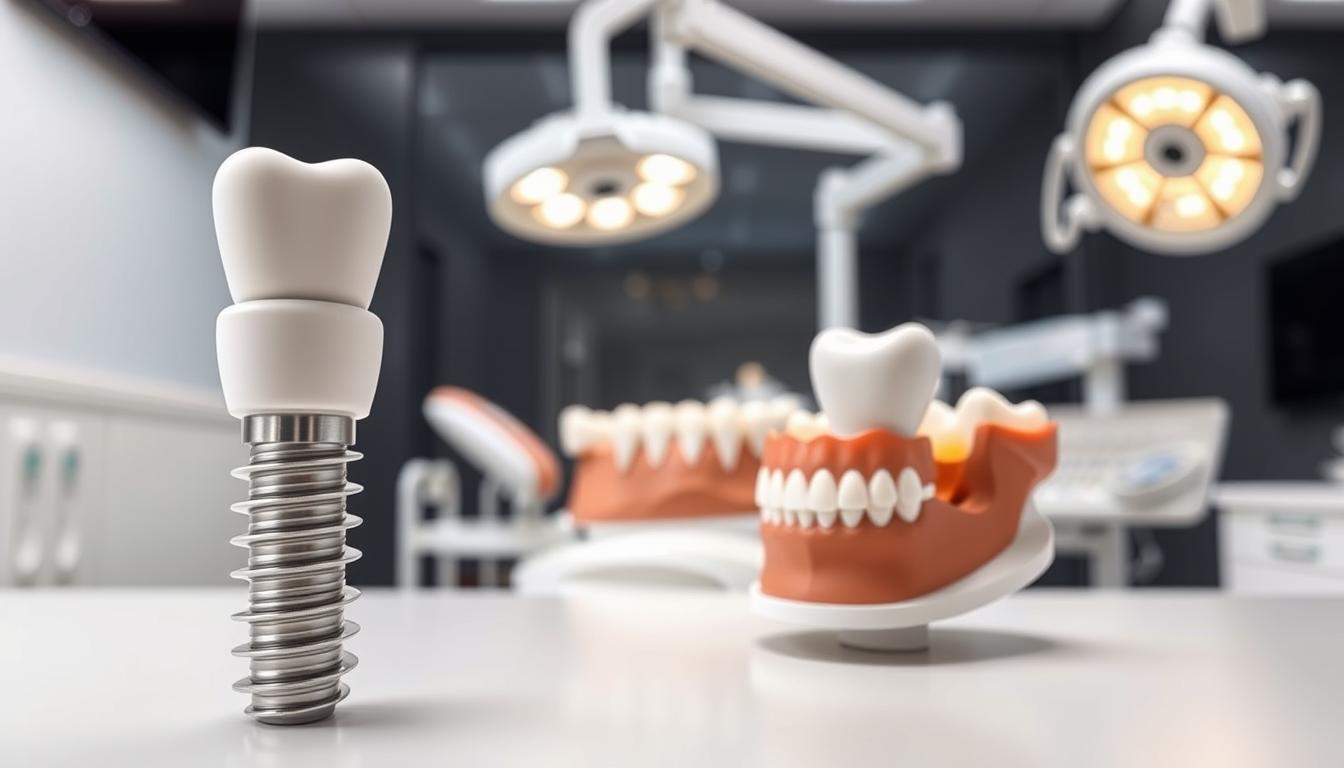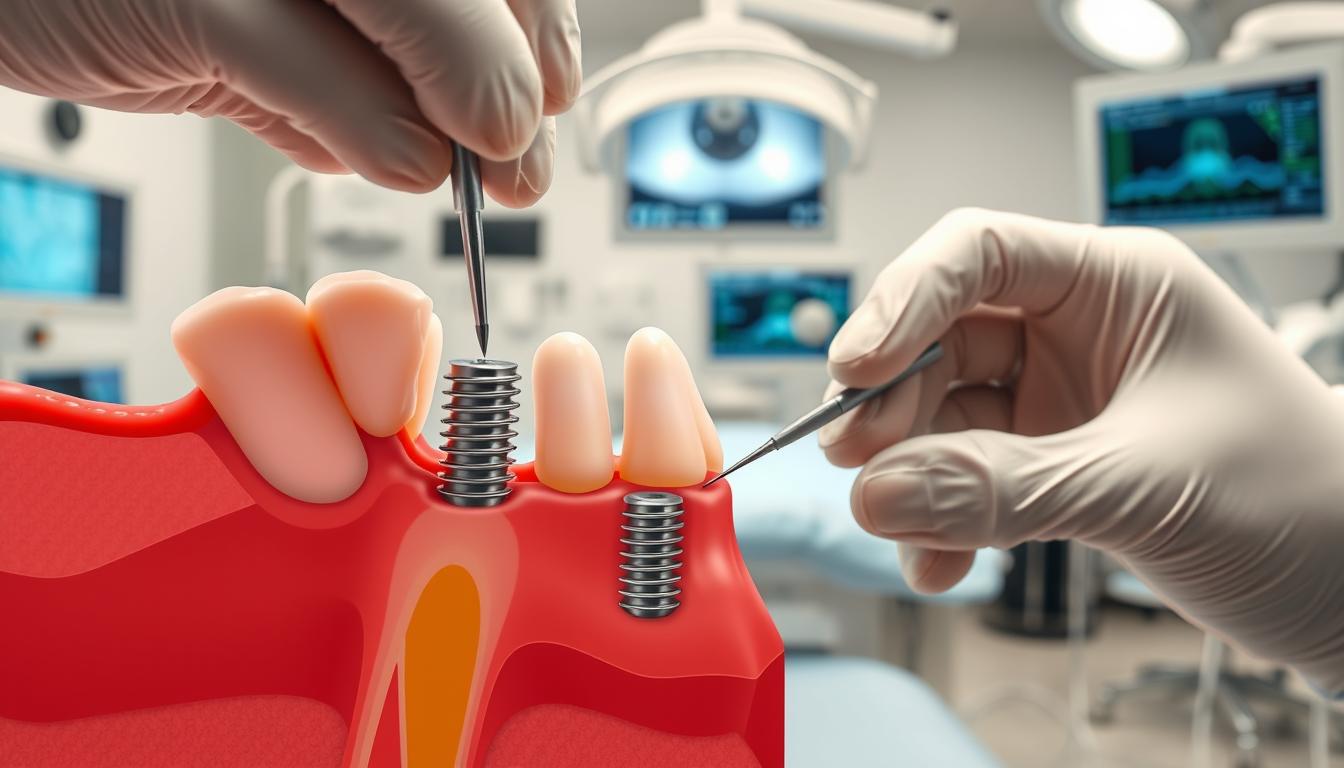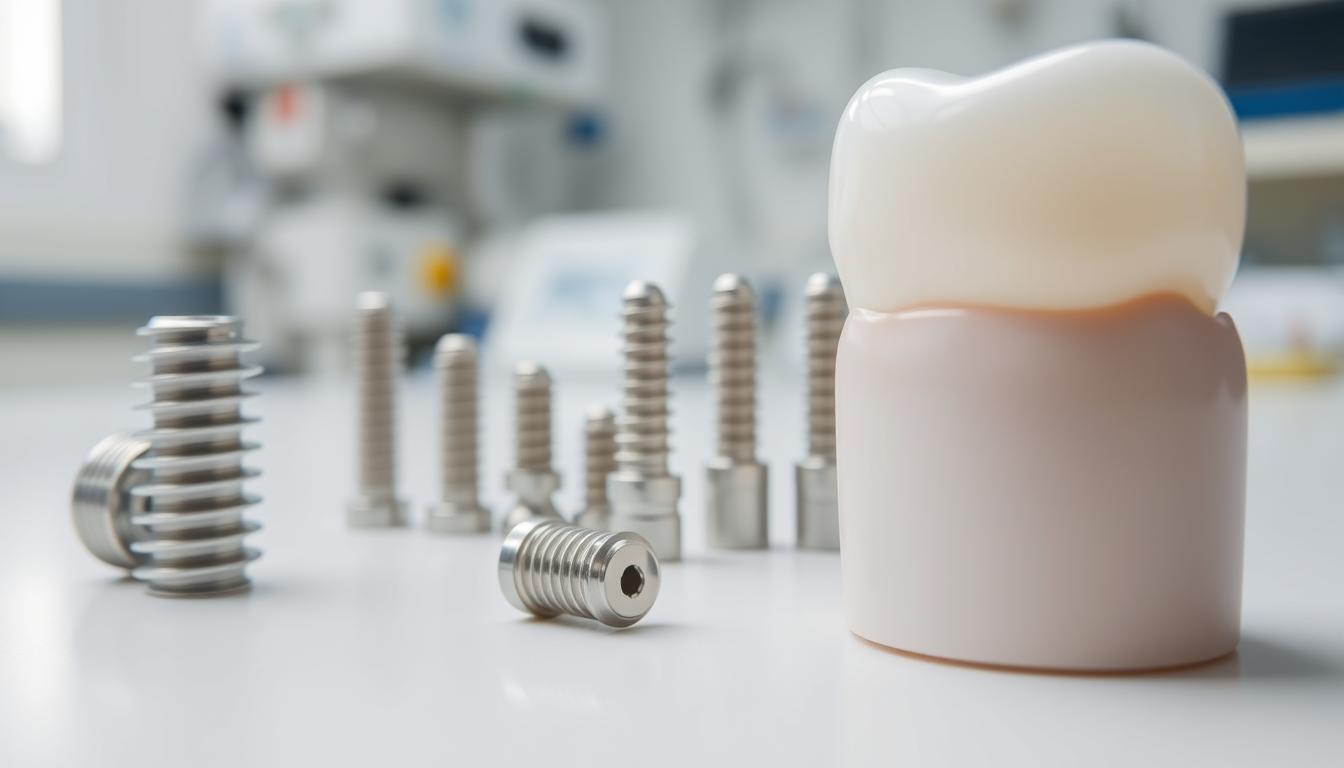Looking for a perfect smile often leads to searching for durable and good-looking options. What is a dental implant? A dental implant is a prosthetic tooth root placed into your jawbone to support a replacement tooth or bridge. This procedure involves placing a metal post, usually titanium, that fuses with the bone, mimicking a natural tooth root.
The materials used are chosen carefully to blend with your jawbone. This helps avoid decay and keeps your bone healthy.
The success rate of dental implants is impressive. It shows they work well, lasting through daily life. Could they be the key to bringing back your smile’s beauty and function?”

Key Takeaways
- Understanding the intricate dental implant procedure offers a window into modern dental solutions.
- Knowledge of dental implant materials underscores the importance of quality and compatibility in oral health.
- Gauging the dental implant success rate provides perspective on the reliability and longevity of this dental innovation.
- Recognizing how dental implants preserve jawbone health and prevent further decay.
- Appreciating dental implants as a superior option for replicating the look and functionality of natural teeth.
Understanding Dental Implants
Starting your journey with dental implants means first understanding what they are and how they work. Knowing the benefits of dental implants is key.
The Definition of a Dental Implant
For those looking to replace missing teeth, knowing what a dental implant is is crucial. A dental implant is a strong, usually titanium, fixture that acts as a tooth root. It’s placed in the jawbone and supports a new tooth or bridge, making it look natural.
How Dental Implants Work
To understand dental implants, you need to know about the three main parts: the implant, the abutment, and the crown. The implant is first placed in the jawbone, where it bonds with the bone. Then, an abutment is attached to hold the crown, making the tooth functional and looking good.
The History and Evolution of Dental Implants
The history of dental implants is a story of medical progress. From simple beginnings, today’s implants use advanced materials and methods. This history shows how reliable and effective these implants are, highlighting their benefits of dental implants.

A dental implant consultation is a vital step. It’s where a personalized treatment plan is made. Knowing the basics helps make informed choices and sets you on the path to a confident smile.
What is a Dental Implant?
Dental implants are a key part of modern dentistry. They replace missing teeth well. Losing a tooth can hurt how your mouth looks and works. That’s why dental implants are a good choice, offering strength and beauty.

These implants are made from top-notch dental implant materials. They have a titanium screw that blends with the jawbone. This screw supports the crown on top, keeping the jawbone strong.
Dental implants have a high dental implant success rate. They work well for about 97% of people over ten years. This success is thanks to better technology and skilled dental implant specialists. These experts make sure implants fit right and care for patients well.
Many people pick dental implants because of their many benefits. They make teeth work and look like new again. They also last a long time, improving life a lot. If you’re thinking about implants, talking to a dental implant specialist is a smart move.
The Dental Implant Procedure Explained
Starting a dental implant procedure is a detailed process. It aims to bring back your smile’s look and function. It starts with a key dental implant consultation to check if you’re a good candidate.
The Initial Consultation
The first step is a detailed dental implant consultation. Here, a specialist checks your oral health and talks about your medical history. They also use special imaging to plan the surgery just for you.
Preparation and Jawbone Evaluation
Before the surgery, you need to prepare. This includes checking the jawbone’s health. If it’s not strong enough, a bone graft might be needed. This adds time to the procedure.
The Implant Surgery Process
The main part of the surgery is placing the implant in the jawbone. This is like a tooth root. You’ll be comfortable thanks to anesthesia, which is key for the implant to bond with your bone.

Post-Surgery Care and Recovery
After the surgery, you focus on recovery and care. You’ll need to manage pain and keep the area clean to avoid infection. This healing time is crucial for the implant to bond with your bone.
Following each step of the dental implant process carefully leads to a restored smile. It also brings back your confidence and improves your life. Every stage, from the first consultation to post-surgery care, is important for the best results.
Types of Dental Implants and Materials
Choosing the right dental implant and material is key for success and comfort. This section looks at the different types of implants and their materials. Knowing these options helps patients make better choices with their dentists.
Different Types of Dental Implants
There are three main types of dental implants, each with its own unique features:
- Endosteal implants are the most common. They are placed directly into the jawbone. Made of titanium, they look like small screws.
- Subperiosteal implants sit on top of the jawbone but under the gum. They’re an option for those without enough jawbone for endosteal implants.
- Zygomatic implants are placed in the cheekbone, not the jawbone. They’re the least common type.

The right implant depends on bone quality, tooth location, and dental health.
Materials Used in Dental Implants
The materials for dental implants must be safe for the body. Here are some common dental implant materials:
| Material | Properties | Common Use |
|---|---|---|
| Titanium | Highly durable, biocompatible | Standard for most Endosteal implants |
| Zirconia | Metal-free, hypoallergenic | Alternative to titanium, used in cases of metal sensitivities |
| Polymer | Aesthetic flexibility | Provisional prosthesis |
To learn more about dental implant materials, talk to your dentist. They can help you choose the best material for your needs.
Benefits of Dental Implants
Looking into the benefits of dental implants shows many good points. They are a strong fix for missing teeth and boost your dental and overall health. One big plus is they improve your speech. Unlike dentures, implants stay put, helping you speak clearly and naturally.
Dental implants have a high dental implant success rate, over 95% in studies. This success shows their strong design and the tech used to fit them to your teeth. Plus, they help grow your jawbone, stopping bone loss from tooth loss.
- Preserve natural tooth tissue by not needing to cut down nearby teeth for bridges.
- Lessen the load on your teeth and mouth by supporting crowns, bridges, and dentures.
- Improve your health by keeping your mouth healthy.
- Boost your self-esteem and confidence with a natural feel of real teeth.
The key to dental implants is how they fit with your jawbone. This is for comfort, chewing well, and lasting long. They are a permanent fix, lasting a lifetime, making them a smart investment in your oral health. They also look natural, bringing back the joy and confidence of a full, healthy smile.
Comparing Dental Implants vs Bridges
When you’re looking to replace a tooth, knowing the difference between dental implant vs bridge is key. Both have their own benefits, but your choice might depend on cost, health, and how long you want the solution to last.
What Are Dental Bridges?
Dental bridges are a traditional way to replace missing teeth. They have an artificial tooth held by crowns on the teeth next to the gap. Unlike dental implants, bridges don’t replace the tooth root and need the teeth next to them for support. This can be good or bad, depending on the health of those teeth and your overall health.
Key Differences Between Implants and Bridges
The main difference is how they’re supported. Dental implants are put directly into the jawbone, replacing the tooth root. They provide strong, lasting support for artificial teeth. This helps keep the jaw structure and prevents bone loss from missing teeth. Bridges, however, rely on the teeth next to the gap for support, which can strain those teeth over time.
Pros and Cons of Each Option
Choosing between dental implant vs bridge means looking at their pros and cons and what you need.
| Feature | Dental Implant | Dental Bridge |
|---|---|---|
| Longevity | Can last over 15 years with proper care, maintaining functionality and appearance. | Typically lasts 5-7 years, might need replacement sooner depending on care and placement. |
| Impact on Adjacent Teeth | None, as the implant does not rely on other teeth for support. | Requires alteration of adjacent teeth to anchor the bridge, which can lead to future complications. |
| Bone Health | Preserves jaw bone and prevents bone loss through osseointegration. | Does not prevent bone loss where the tooth is missing, as no root structure is replaced. |
| Initial Procedure | More invasive, requires surgery and longer healing time. May require multiple visits over several months. | Less invasive, can often be completed in two visits over a few weeks. |
| Cost | Higher initial cost but less likely to need replacements. | Generally lower initial cost, but potentially higher long-term costs due to replacements. |
For more details on both dental solutions, you can read further here.
Whether you choose a dental implant procedure or a dental bridge depends on your dental health, budget, and what you prefer. Each option has its benefits. Talking to a dental professional can help you make a choice that’s right for you.
The Cost of Dental Implants
Knowing the dental implant cost is key for those thinking about this permanent tooth replacement. Prices change based on several things like the material, how many implants, and the procedure’s complexity. We’ll look at these costs and how to get dental implant financing and dental implant insurance.
Other things like the dentist’s skill, where you are, and the technology used also affect the cost. It’s important for patients to know the financial commitment before starting treatment.
Factors Influencing the Cost
- Type of implant and materials used
- Number of teeth being replaced and their location in the mouth
- Additional procedures required, such as bone grafts
Financing and Insurance Options
Many feel the cost of dental implants is too high. But, there are financing plans that can make it more affordable. Here’s a table showing typical coverage and financing plans.
| Option | Description | Typical Coverage |
|---|---|---|
| Dental Insurance | Some plans cover a part of the implant cost. | Up to 50% for surgical procedures |
| Payment Plans | Many dental offices offer plans to pay over time. | N/A |
| Health Savings Accounts (HSA) | Can be used for eligible out-of-pocket expenses. | 100% up to the account balance |
| Medical Credit Cards | For health expenses, often with 0% APR promotions. | Dependent on credit limit |
Having dental implant insurance and financing options can help with the initial cost. It makes this life-changing treatment more affordable. It’s wise to talk to your dental office about the best options for your budget.
Selecting a Dental Implant Specialist
Choosing the right dental implant specialist is key to a successful implant. You need to know what makes a specialist good for your needs. They should be confident and safe in their work.
At your dental implant consultation, you can ask important questions. You’ll learn about the specialist’s experience and what results you might see. This helps you make a smart choice.
| Qualifications | Questions to Ask |
|---|---|
| Board Certification in Oral and Maxillofacial Surgery, Periodontics, or Prosthodontics | What is your success rate with dental implants? |
| Years of Experience with Dental Implants | Can you describe the types of implants you use and why? |
| Continued Education in Implant Dentistry | What should I expect in terms of aftercare and potential risks? |
With this information, you can trust your smile’s journey to a certified and skilled dental implant specialist. They will guide you well and achieve great results.
Dental Implant Care and Maintenance
Keeping dental implants in good shape is key. A daily oral hygiene routine is crucial. It keeps your implants and your mouth healthy. Let’s look at how to care for your dental implants every day and in the long run.
Daily Care Routine
Good daily care is vital for your implants. Here’s what you should do:
- Brush twice a day with a soft-bristled toothbrush to avoid scratching the implants.
- Use a non-abrasive toothpaste for implants to prevent damage.
- Floss daily with unwaxed tape or implant-specific floss to clean around implants and protect your gums.
- Use an interdental brush to remove plaque from hard-to-reach areas around the implant.
Long-Term Maintenance Tips
For implants to last long, long-term care is important:
- Go for regular dental check-ups every six months to keep an eye on your implants and catch any problems early.
- Avoid chewing on hard items like ice or hard candy to prevent damage to your implants and teeth.
- Stay healthy by avoiding tobacco and too much alcohol, which can harm your implants.
Following these care tips can make your implants last longer and work better. Good oral hygiene is a big commitment. But it’s worth it to keep your smile and mouth healthy.
Risks and Complications of Dental Implant Surgery
Dental implant surgery is very successful and effective. But, like any medical procedure, it has dental implant procedure risks. Knowing these risks helps you make a better choice and talk about any worries with your dentist.
Some common problems with dental implant surgery include:
- Infection at the implant site, which can affect both the gums and the bone.
- Injury or damage to nearby teeth and blood vessels during surgery.
- Nerve damage, leading to numbness or pain in the teeth, gums, lips, or chin.
- Sinus complications when implants in the upper jaw reach the sinuses.
Let’s look at some statistics to understand these risks better:
| Complication | Incidence Rate |
|---|---|
| Infection | 5% |
| Nerve Damage | 1-3% |
| Sinus Issues | 2% |
| Dental Injury | Less than 1% |
Some things can make these risks higher:
- Poor oral hygiene can make infections worse.
- Medical conditions like diabetes or osteoporosis can slow healing.
- Smoking can slow healing and weaken bone needed for implants.
If you’re thinking about dental implants, talk to your dentist about risks and complications. This way, you’re ready and can get the best results with fewer problems.
The Success Rate of Dental Implants
When it comes to long-lasting dental implants, patients find comfort in their high dental implant success rate. Most implants last for decades with proper care. The success depends on the jawbone quality, patient health, and oral hygiene.
Non-smokers often see better results than smokers. Smoking can harm the implant’s integration with the jawbone.
If the bone doesn’t bond well with the implant, it might fail. But, this can be a chance to try again after healing. Regular dental check-ups are key to keeping implants successful.
| Factor | Impact on Success Rate |
|---|---|
| Quality of Jawbone | Critical for supporting the implant, high quality ensures better osseointegration. |
| Smoking Habits | Smoking can delay healing and reduce success rate. |
| Oral Hygiene | Good practices can extend the lifetime of the implant significantly. |
| Overall Health | Healthier patients tend to experience higher success rates. |
| Regular Dental Visits | Essential for monitoring the implant’s condition and taking preemptive actions against potential issues. |
By managing these factors well, you can ensure a high dental implant success rate. This makes implants a great choice for those looking for a permanent tooth solution. Avoiding smoking and keeping good oral health can greatly improve your implant’s longevity and function.
Who is a Good Candidate for Dental Implants?
Finding the right dental implant candidates is important. These implants are a lasting fix for missing teeth. But, they need certain conditions to work well. Knowing who will benefit most helps avoid problems.
Evaluating Your Suitability for Implants
Thinking about dental implants? You’ll need to go through some checks. Important things to look at include:
- Age: Your jawbone needs to be fully grown. Implants are best for people in their late teens or early twenties and up.
- Bone Density: Your bones must be strong enough to hold the implant. If they’re not, you might need a bone graft first.
- Oral Health: Good gums and teeth are key. Gum disease can hurt the implant’s chances of success.
- Lifestyle: Not smoking and avoiding substance abuse helps. These habits help your body heal better.
- Commitment to Care: You must be ready to keep your mouth clean and see the dentist regularly.
Want to know if you’re a good fit for dental implants? Check out this guide.
Health Conditions That Affect Implant Success
Dental implants are a great option for many. But, some health conditions can make success harder. Problems like uncontrolled diabetes and autoimmune diseases can slow healing.
- Diabetes: If your diabetes is well-managed, implants might work. But, uncontrolled diabetes can lead to implant failure.
- Medications: Some meds can mess with bone growth or your immune system. This might hurt the implant’s success.
- Osteoporosis: This condition, especially with certain treatments, can weaken bones. This makes implants harder to place and less likely to work.
Talking to a dental expert about your health conditions and dental implants is key.
Dental Implant Innovations and Future Trends
The need for better dental treatments is growing. Implant dentistry is making big strides. New technologies and materials aim to make dental implants more effective and comfortable for patients.
Technological Advances in Implant Dentistry
New dental implant technologies focus on the patient. Titanium alloys have made implants stronger and longer-lasting. Surface changes also help implants blend better with bone.
Digital tools are changing dental implants too. Software for 3D imaging and planning makes implants more precise. This means less chance of error and faster recovery times.
The Future of Dental Implants
The future of dental implants looks very promising. 3D printing could change how implants are made. It allows for implants that fit perfectly with a patient’s teeth.
Another big hope is for implants that help heal faster. These implants could release substances that aid in bone growth and prevent infections. This could make implants even more successful in the long run.
As these advancements grow, dental implants will become more common and successful. They will be a top choice for people looking for a lasting solution to tooth loss.
Conclusion
Knowing what is a dental implant is key for those thinking about it. Dental implants are a strong, lasting fix for missing teeth. They do more than just make your smile look good.
They help keep your jawbone strong, improve how your mouth works, and boost your oral health. This makes them a top choice for those who want something that lasts and looks great.
Finding the right dental implant specialist is very important. Their skill can make a big difference in how well the implant works. With the right care and a skilled specialist, dental implants can change your life for the better.
Dental implants are valuable for many reasons. They can make your mouth work better, look better, and keep your teeth healthy. If you want a reliable, long-lasting fix for your teeth, dental implants are a great option.
They offer a high success rate and can greatly improve your life. Dental implants are a smart choice for your dental health and overall wellbeing.
FAQ
What exactly is a dental implant?
A dental implant is a permanent tooth replacement. It’s made from materials like titanium. It acts as an artificial tooth root and supports a crown, bridge, or denture.
How do dental implants work?
Dental implants work by fusing with the jawbone. This process is called osseointegration. After the metal post is implanted, it becomes a stable base for the artificial tooth.
Can anyone get dental implants?
Most adults with missing teeth can get dental implants. You need a fully grown jawbone, enough bone density, and healthy tissues. You also can’t have conditions that stop bone healing.
What does the dental implant procedure involve?
The process starts with a consultation and dental exam. Then, the metal post is placed in the jawbone. After healing, the abutment and artificial tooth are attached.
How long does a dental implant procedure take?
Dental implants take several months. This includes surgery, healing, and placing the crown. Sometimes, bone grafting is needed, which adds to the time.
What are the benefits of dental implants over other tooth replacement options?
Dental implants look and feel like natural teeth. They improve your appearance, speech, and comfort. They also help keep your jawbone healthy and don’t harm other teeth.
Are dental implants expensive?
Dental implants vary in cost. It depends on location, the dentist’s expertise, and procedure complexity. Many offices offer financing to help with the cost.
How do I choose a dental implant specialist?
Choose a specialist with the right certifications. Look for experience and success rates. Ask about their aftercare during your consultation.
How should I care for my dental implants?
Keep your implants clean with regular brushing and flossing. Visit your dentist for check-ups. Avoid chewing hard items to protect your implants and teeth.
What are the risks associated with dental implant surgery?
Risks are rare but include infection and nerve damage. A skilled dentist can minimize these risks. Sinus complications are also possible but rare.
What is the success rate of dental implants?
Dental implants have a high success rate, over 95%. Success depends on proper placement, jawbone quality, and good oral hygiene.
What is the difference between a dental implant and a bridge?
Implants replace the whole tooth, including the root. They stand alone and don’t harm other teeth. Bridges use nearby teeth as anchors and don’t go into the jawbone.
What technological advancements are being made in implant dentistry?
New materials and techniques are being developed. This includes better implants, faster healing, and more precise placement. Digital imaging and 3D printing are also improving.
Can dental implants help if I’ve lost all my teeth?
Yes, implants can support full dentures or multiple bridges. They offer a natural and comfortable alternative to traditional dentures.

wd552a
Nice post! 1754820688
THANK YOU
THANK YOU SIR
THANK YOU SIR